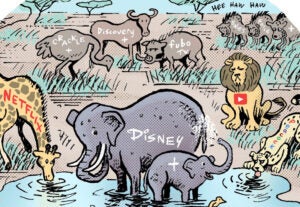Turner will activate first-party data from AT&T’s 40 million set-top boxes to improve targeting and attribution for its linear TV offering, the company said Tuesday. The capability will be generally available Q1.
AT&T’s set-top data, available through the Xandr ad unit, could already be applied to Turner’s digital properties, as of Q4 2018.
These data sets, made available through AT&T’s ad unit Xandr, “supercharges” Turner’s five-year-old AudienceNOW platform, Turner ad sales president Donna Speciale told AdExchanger.
“We did a beta this year with AT&T Mobility and saw a 30% increase [reaching its preferred audience segment] versus buying [linear inventory] the traditional way,” Speciale said.
AudienceNOW previously didn’t access set top box data, Xandr’s SVP of corporate strategy and business development, Mike Welch, told AdExchanger.
Because Turner now has access to that data in-house, it can do linear attribution a lot faster than before.
“Anytime you’re using first-party data, it’ll be more accurate and deliver better results,” Welch said. “We’ll also be able to speed up the reporting process much quicker.” Welch predicts reporting can now take two weeks or less, whereas it previously took up to twelve weeks.
And advertisers can now buy Turner both linear and digital inventory based on business outcomes.
“One of the reasons that [clients] obviously have been turning to digital is because digital has been doing a great job in providing business outcomes,” Speciale said. “That has been a big challenge in the linear space. We have not been able to crack that code.”
So advertisers can buy inventory, for instance, based on whether an ad generated in-store traffic, since Turner can use AT&T location data. Or they can buy based on whether a target segment opened an app, since AT&T knows how people use their phones.
Since the majority of advertisers’ dollars is still on linear TV, it was important for Turner and AT&T to come up with a solution that allowed for guaranteed outcomes, Speciale added.
Custom segments from Xandr
AdExchanger Daily
Get our editors’ roundup delivered to your inbox every weekday.
Daily Roundup
Xandr also created 30 custom segments from AT&T first-party data for Turner’s digital properties, said Welch, built from consumer behavior, mobility data and broadband data.
“We allow Turner to activate on those custom segments, so it’s 135 million monthly active users on those digital properties,” Welch said.
Right now, those segments can’t be applied to Turner’s linear inventory – though that’s in the works.
“We’re not cross-selling it yet, but we will,” Welch said. “Those customer segments will be available for both linear and digital at some point.”
So when can advertisers expect to do a combined digital-linear buy programmatically? Welch said he hopes it happens by the end of 2019.
Telco data finally comes into play
The idea of using first-party data to create custom audience segments and improve attribution capabilities is not new. The industry has been focused on this for the last few years.
“It’s 100% possible to do this,” said Jamie Power, COO, one2one addressable at Cadent. “I don’t know if this has been done at scale because it’s pain to execute, but this should make [targeting and attribution] easier to do.” This would, of course, only be available within AT&T’s environment, Power added.
But it’s still a unique capability – and AT&T is in the process of activating telco data for its ad unit, the way Oath had once hoped Verizon would.
“There have been a couple of big mega-mergers in the past where this combination would yield incredible results for advertisers,” Speciale said. “Those things never came to fruition.”
But six months after AT&T closed on its Time Warner merger, she noted that Turner is already harnessing AT&T data and technology.















